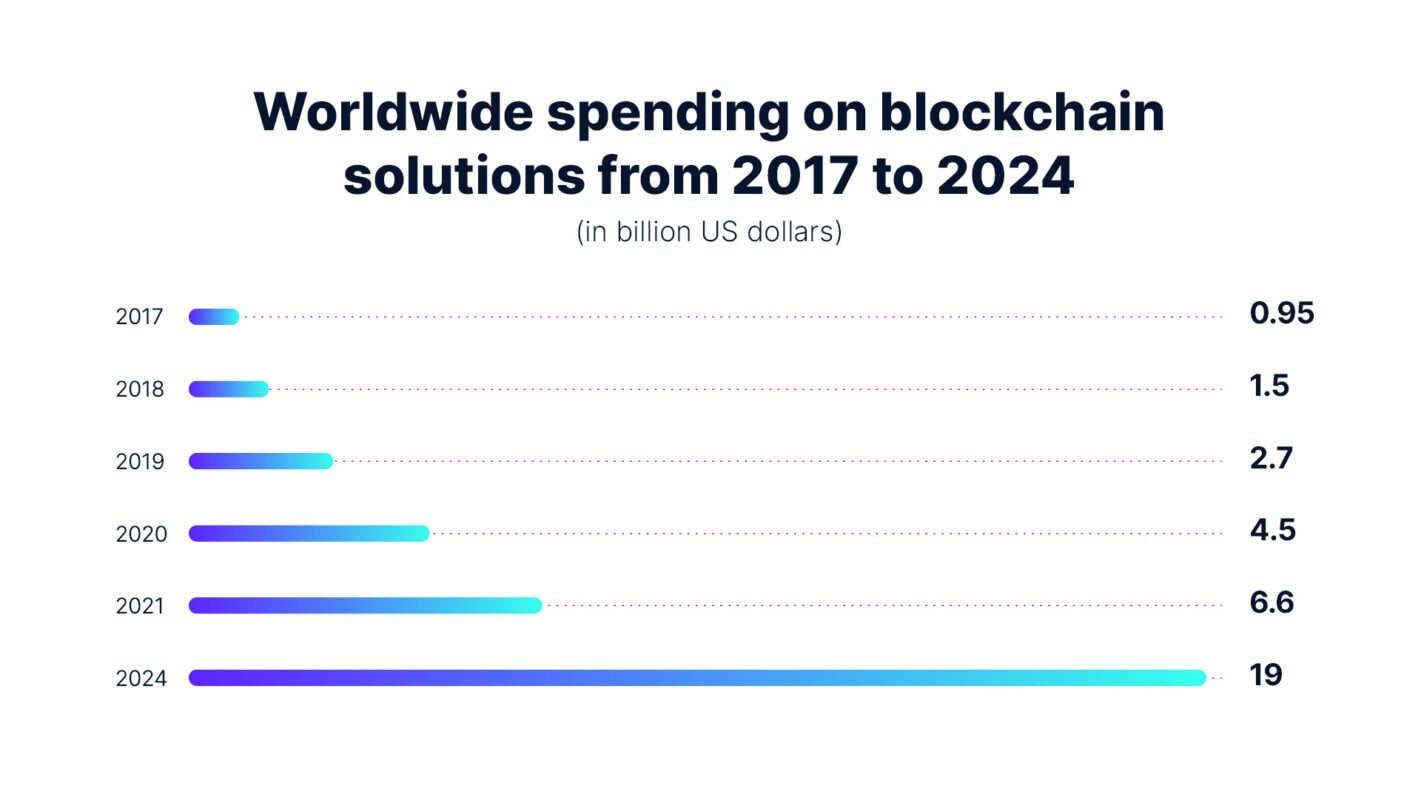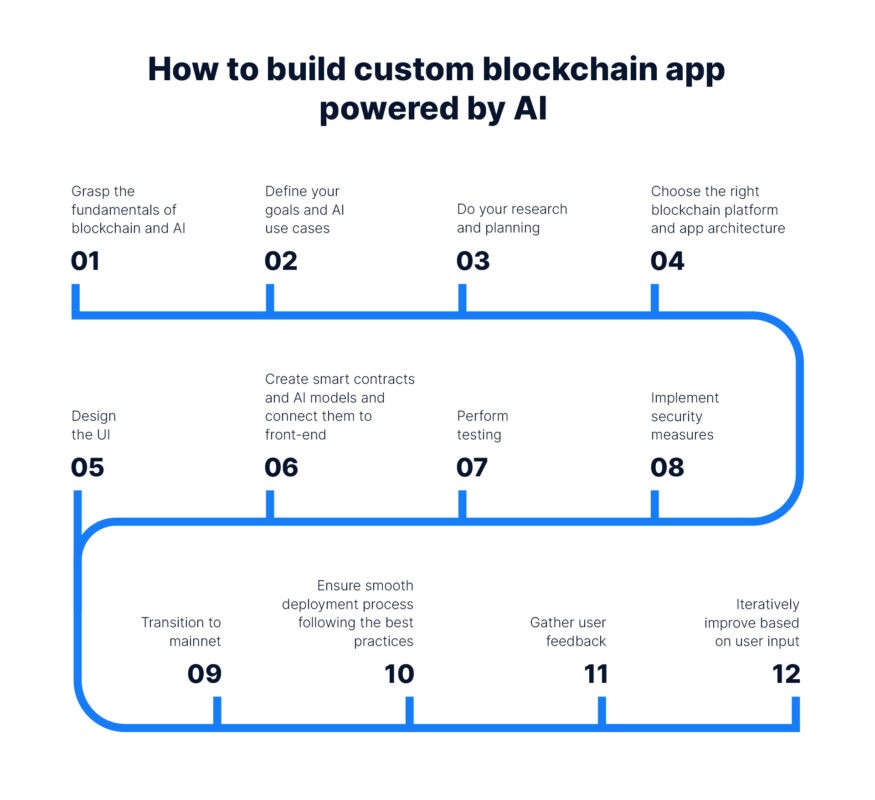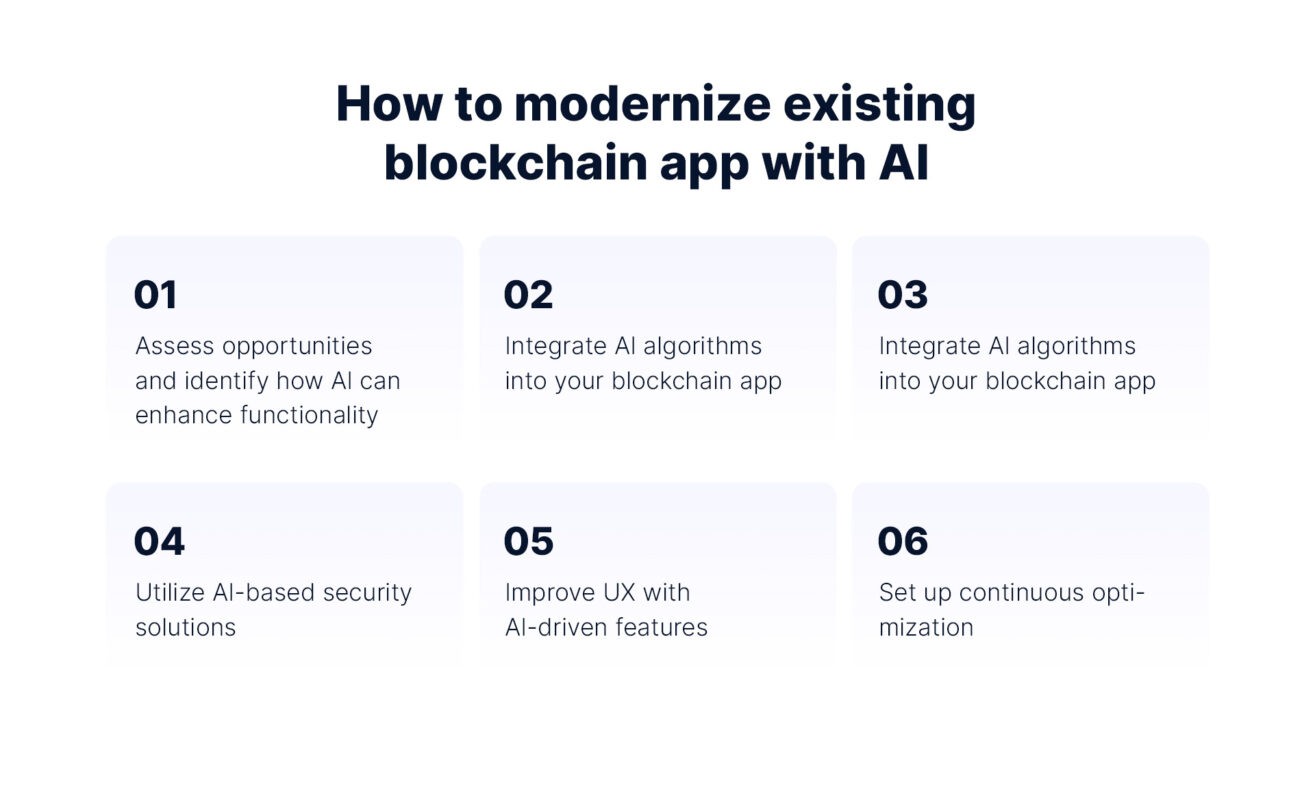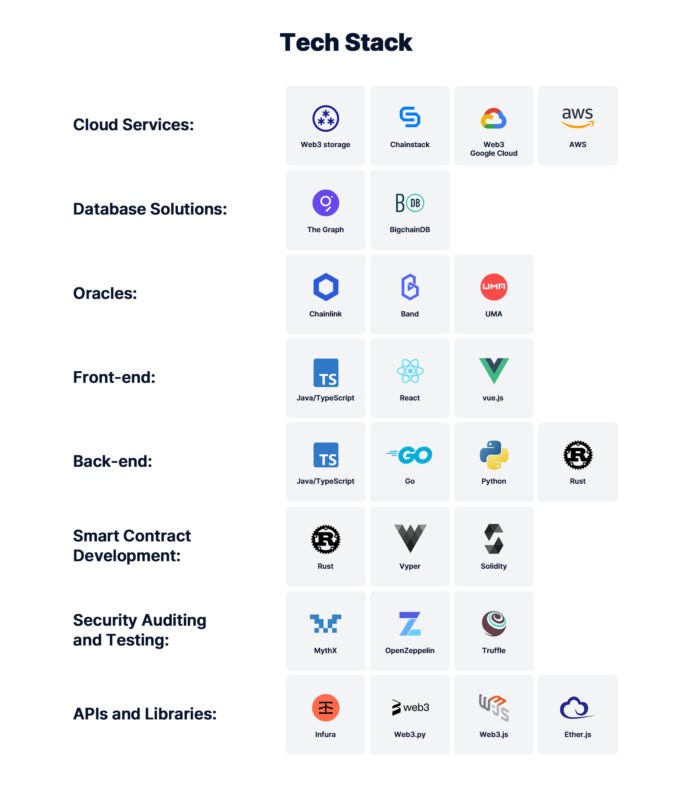
January 01, 2025
Go-To Roadmap to AI-Powered Blockchain App Development and Modernization in 2026
MarketsandMarkets reports that the global blockchain market is expected to grow to over $94 billion by 2027, with a yearly growth rate of 66.2%. Statista suggests that worldwide spending on blockchain solutions will reach nearly $19 billion by 2026. By 2030, Gartner estimates that blockchain could generate business value of around $3.1 trillion, potentially overseeing 10% to 20% of the global economy.

The financial sector makes up over 30% of the blockchain market, but industries like manufacturing, agriculture, distribution, services, and the public sector are also rapidly adopting blockchain.
In this article, we will explore the latest trends in blockchain technology, 20 practical steps for developing custom AI-powered blockchain applications from scratch, and strategies for modernizing and empowering existing blockchain solutions with AI integration. Besides, we will address important considerations and challenges in blockchain app development, including selecting the best tech stack, estimating development costs and timelines.
Blockchain trends to embrace in 2026
Blockchain app development in 2026 promises significant advancements, with several trends emerging to shape the landscape. These trends indicate the technology's continued growth and its impact across various industries. Let's explore the key trends driving blockchain app development in 2026.
Enhanced Interoperability
Blockchain platforms are increasingly focusing on interoperability, allowing different networks to communicate seamlessly. This trend facilitates the exchange of assets and data between diverse blockchain ecosystems, fostering collaboration and innovation.
Decentralized Finance (DeFi) Expansion
The DeFi sector continues to expand, offering a decentralized system of financial services such as lending, borrowing, and trading. In 2026, we can expect further growth in DeFi applications, driven by increased adoption and innovation in areas like yield farming and decentralized exchanges.
NFT Evolution
Non-Fungible Tokens (NFTs) are evolving beyond digital art and collectibles, finding applications in areas like gaming, real estate, and intellectual property. In 2026, NFT technology is poised to witness further evolution and adoption, unlocking new opportunities for creators and investors.
Sustainability and Green Blockchain
With growing concerns about the environmental impact of AI and blockchain technology, there's a rising focus on sustainability and green blockchain solutions. In 2026, we anticipate increased efforts to develop energy-efficient consensus mechanisms and carbon-neutral blockchain infrastructure.
Enterprise Blockchain Adoption
Enterprises are increasingly recognizing the potential of blockchain technology and AI models to streamline operations, enhance transparency, and drive efficiency. In 2026, we can expect continued adoption of blockchain solutions across industries, with a focus on use cases such as supply chain management, identity verification, and data security.
Looking ahead to 2026, the trends we discussed above underline exciting opportunities and challenges for blockchain app development. By staying abreast of these developments and embracing innovation, businesses can harness the full potential of blockchain technology to drive growth and transformation.
How to develop custom AI powered blockchain app: A step-by-step guide
Starting the process of building a blockchain app might seem overwhelming, but with the right plan, it becomes easier and more rewarding. At Artkai, we recommend using these 20 steps that help you navigate the challenges of blockchain app development, from understanding the technology of AI services to deploying your application.

At the beginning
Step 1. Understanding Blockchain and relevant AI models
Before diving in, it's essential to grasp the fundamentals of blockchain and AI technology. Learn about its decentralized nature and how it securely records transactions across a network.
Step 2. Define Your Goals
Clearly define the objectives and use cases for your AI-powered blockchain application. Determine how AI can enhance your blockchain solution. Basically, it can improve automation, data analysis, or decision-making processes. Define use cases of AI features that align with your business objectives.
Selecting the relevant blockchain model
Step 3. Research and Plan
Conduct thorough research on existing blockchain applications and market trends. Use this information to create a detailed plan for your project, outlining the steps needed to achieve your goals.
Step 4. Choose the Right Platform
Choose a suitable blockchain platform that supports AI integration and development. Basically, you can choose from Ethereum, Hyperledger, or Corda. While selecting the best fit for your app, consider factors like scalability, consensus mechanism, and smart contract support.
Prepare your development environment
Step 5: Set Up Your Development Environment
To start, developers typically install and configure the necessary tools and frameworks for blockchain development. This includes choosing the right integrated development environment (IDE).
Design your blockchain app
Step 6: Plan Your Blockchain App's Architecture
Design the architecture of your blockchain app to accommodate AI integration. Define how AI algorithms will interact with the blockchain network and data. You need a systematic approach to ensure a strong and efficient framework. Here's a breakdown: begin with Technical Specifications, define core, advanced features, and technology stack, create UX user flow, integrations, and API endpoints.
Step 7: Design the User Interface
Craft a user-friendly platform that clearly showcases the blockchain app's advanced features. Prioritizing UX/UI in blockchain app development based on Guide to Creating Blockchain UX enhances usability, making decentralized applications more accessible and appealing to a wider audience. Determine whether to create a desktop, mobile, or web-based application.
Develop smart contracts
Step 8: Create Smart Contracts and AI models
Crafting smart contracts involves using specialized programming languages, such as Solidity for Ethereum, or languages compatible with the chosen blockchain platform. Also, you need to utilize AI frameworks like TensorFlow or PyTorch for AI model development. Ensure thorough testing and validation of both smart contracts and AI models.
Implement frontend
Step 9: Connect Frontend to Smart Contracts and AI models
You need to build seamless integration between the user interface, smart contracts, and AI models to enable data exchange and transaction processing. In blockchain application development, this process aims to establish communication between the user interface and smart contracts deployed on the blockchain.
Test your blockchain app
Step 10: Perform Testing
Thoroughly test your smart contracts and the integration of your front-end, AI models, and their integration with the blockchain network. Conduct comprehensive unit testing of your smart contracts to ensure application security and functionality. Test for security vulnerabilities, performance issues, and data accuracy as well.
Deploy the blockchain app
Step 11: Implement Security Measures
Prioritize security by addressing common vulnerabilities such as reentrancy, overflow, and unauthorized access. Use AI-based security solutions and machine learning algorithms to detect and mitigate potential threats.
Step 12: Transition to the Mainnet
Transitioning to the Mainnet marks the readiness of your blockchain application for deployment on the production network.
Step 13: Ensure a Smooth Deployment Process
Learn strategies to ensure a smooth deployment process, minimizing disruptions and ensuring a positive user experience.
Step 14: Understand Deployment Best Practices
For instance, avoid deploying on Fridays to mitigate the risk of post-deployment issues during the weekend when resources and team availability may be limited.
Conduct user testing and feedback
Step 15: Gather User Feedback
Implement effective strategies for collecting valuable user feedback to guide iterative improvements. Use AI-driven analytics to analyze user behavior and preferences to implement the most relevant improvements for your app.
Step 16: Iteratively Improve Based on User Input
Understand the iterative nature of development and improve the application based on user feedback to create a user-centric blockchain app.
Launch your blockchain app
Step 17: Plan a Successful Launch Strategy
Develop a comprehensive strategy for launching your blockchain app to maximize visibility and user adoption.
Step 18: Promote Your App in Relevant Communities
Explore effective ways to promote your app within relevant communities to generate interest and attract early users.
Step 19: Launch Your App
After testing and refining your blockchain application, proceed to launch it on the mainnet. Announce the release to your intended audience and market the app to gain initial user engagement. Leverage AI-driven marketing techniques for targeted outreach and engagement.
Maintain and upgrade your blockchain app
Step 20: Maintain and Upgrade
Continuously maintain and upgrade your blockchain app to sustain optimal performance and security. Regular updates address evolving challenges, introduce new features, and fortify AI applications against vulnerabilities.
This guide offers a comprehensive roadmap from conceptualization to deployment of your blockchain app, providing insights for developers at all levels. AI and blockchain technology signify a transformative paradigm shift with AI applications beyond cryptocurrencies, promising a future of redefined trust and endless possibilities.
Modernize and empower your existing blockchain solution with AI
Integrating generative AI with blockchain technology means a transformative opportunity for businesses across various sectors, including finance, healthcare, retail, supply chain, and government. From our experience, the integration of blockchain applications with artificial intelligence enhances efficiency, transparency, and security in business operations. AI's smart automation works hand-in-hand with blockchain's secure and unchangeable transaction records, boosting trust and innovation.
For companies seeking to modernize existing blockchain applications with AI, Artkai recommends following these steps:

- Assess Your Opportunities
Begin by assessing your current blockchain solution to identify specific areas where AI integration can enhance functionality, efficiency, or user experience. For example, in healthcare, AI can optimize patient data management, while in supply chain management, it can streamline inventory tracking and logistics.
- Implement Data Integration
Integrate AI algorithms into your blockchain solution to analyze and leverage data more effectively. This may involve preprocessing blockchain data to feed into AI models for predictive analytics, anomaly detection, or pattern recognition. For instance, a healthcare blockchain application could integrate AI algorithms to analyze patient data for early disease detection or personalized treatment recommendations.
- Build AI-powered Smart Contracts
Implement AI-powered smart contracts to automate decision-making processes and enhance the flexibility of your blockchain solution. Smart contracts enriched with AI capabilities can autonomously execute transactions based on predefined conditions, improving efficiency and reducing manual intervention. For instance, in finance, AI-enabled smart contracts can automatically execute trades based on market conditions and user preferences.
- Enhance Security
Utilize AI-based security solutions to detect and mitigate potential threats more effectively. AI-driven security tools can continuously monitor blockchain networks for suspicious activities, identify potential vulnerabilities, and respond to threats in real-time. For example, AI algorithms can detect anomalous transaction patterns indicative of fraudulent activity and trigger preventive measures to safeguard assets and data integrity.
- Work with User Experience
Improve user experience with AI-driven features such as personalized recommendations, intelligent search, or natural language processing interfaces. By analyzing user behavior and preferences, AI can tailor the blockchain application interface to individual users, enhancing engagement and satisfaction. If you have an e-commerce blockchain platform, it can leverage AI to provide personalized product recommendations based on user browsing history and purchase patterns.
- Set up Continuous Optimization
Establish a framework for continuous optimization to monitor and refine the AI components of your blockchain solution. Regularly evaluate performance metrics, gather user feedback, and update AI models to ensure they remain effective and aligned with evolving business needs. Continuous optimization enables your blockchain application to adapt to changing market dynamics and deliver ongoing value to users.
By integrating AI capabilities into your existing blockchain solution, you can modernize and empower it with advanced functionalities, unlocking new opportunities for innovation, efficiency, and growth. This strategic integration aligns your business with the latest technological trends and positions it for success in a rapidly evolving digital landscape.
Things to keep in mind while blockchain app development
The best tech stack for your blockchain app
Choosing the right tech stack for your blockchain application is crucial as it directly affects its functionality, performance, security, and scalability. Opting for the correct platforms, frameworks, and APIs can significantly enhance your solution's value, making it more competitive in the blockchain app market.
To assist you in making relevant decisions, Artkai has gathered the most effective platforms, frameworks, and APIs to boost your blockchain app development:

To maximize the benefits of your tech stack, you need to consider your project requirements, target platforms, and the level of support and community engagement for each component. This tailored combination of AI technologies will enable you to develop a robust, secure, and highly efficient blockchain application tailored to your business processes.
Challenges of blockchain app development
When developing custom blockchain applications, businesses face various technical and implementation challenges. To prepare for your project, we've outlined key challenges in blockchain app development and how Artkai can help address them.
Platform Selection Challenge
Analyze your project's requirements to choose the most effective blockchain platform. Consider factors like consensus mechanisms, scalability, and community support.
Smart Contracts Challenge
Engage experienced developers for smart contract development. Thorough testing and audits are essential to ensure contract reliability.
Integration Challenge
Utilize accurate libraries and APIs for seamless payment processing and user experiences.
Public/Private Network Challenge
Evaluate data sensitivity and user requirements to determine the privacy level of your application, impacting its decentralization.
Adoption and Functionality Challenge
Conduct market research to understand trends and user needs. Design with users in mind, offer unique value propositions, and iterate based on feedback.
Scalability Challenge
Explore scaling solutions like layer-2 scaling or sidechains to improve scalability. Test performance under different conditions and optimize as needed.
Addressing these challenges the right way will help you create a robust, competitive blockchain application tailored to your business needs.
Average development cost and timeline
Based on our experience with 15 Blockchain apps, Crypto, NFT, and AI projects, we've found that the cost of developing a blockchain-based application varies greatly and depends on several factors. To know exactly how much funds and time you need to develop an AI-powered blockchain app, consider this:
- Complexity of the app's architecture
- Size and expertise of your development team
- Technical aspects like integrating blockchain platforms and developing smart contracts, as well as the features and functionalities of the application
- UI/UX design of your blockchain app
- App development timeline
As for delivery time, a simple blockchain-based MVP may take 4-6 weeks to several months, while basic blockchain applications can take around 2-6 months for development, testing, and deployment.
Wrapping up
In 2026, the combination of AI systems and blockchain offers big chances for businesses. As blockchain grows, trends like better connections between systems, more decentralized finance, and the development of NFTs can bring new ideas and growth. Also, combining AI with existing blockchain systems can make businesses more efficient, transparent, and secure.
By solving problems in making blockchain apps and picking the best tech tools, businesses can make strong, competitive apps that suit them. With smart planning and action, the mix of AI and blockchain brings exciting possibilities for the future and long-lasting growth.
Contact Artkai’s team to get an expert consultation on AI and blockchain development services.
Clients and Results
Schedule your free consultation
Don't miss this opportunity to explore the best path for your product. We are ready to delve into the specifics of your project, providing you with expert insights and optimal solutions.
Book your free sessionRead More
Explore articles from Artkai - we have lots of stories to tell
Join us to do the best work of your life
Together we advance the human experience through design.